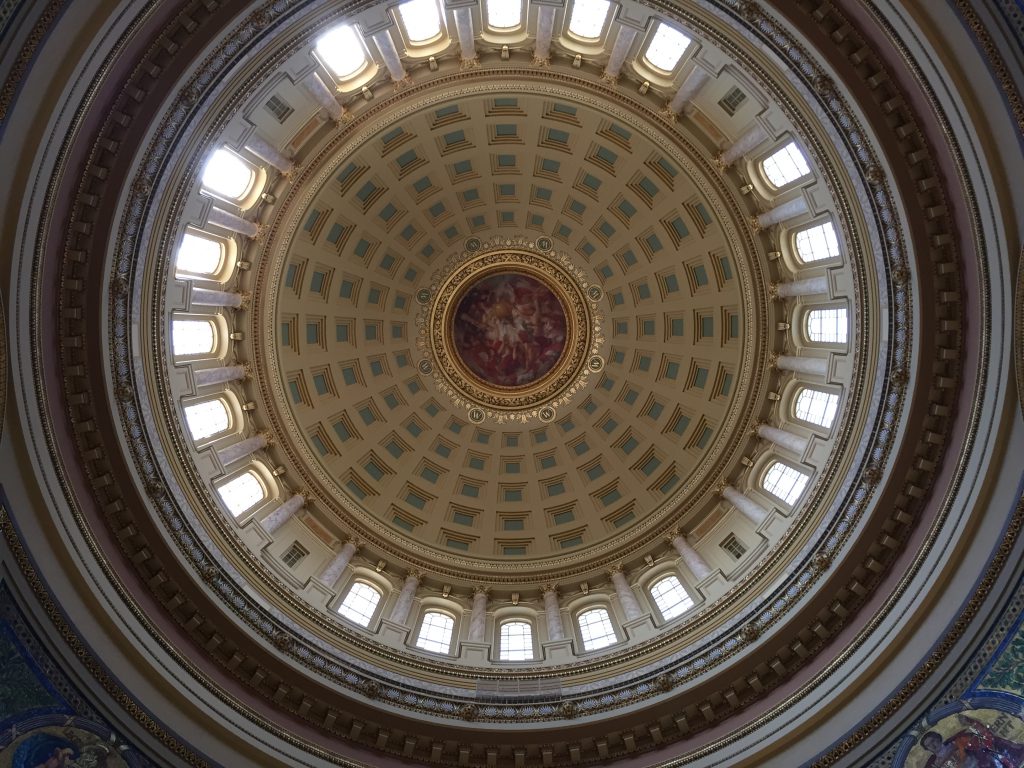Parties Seek New Candidates in New Districts
New state legislative maps means races are the fairest and most wide open in 12 years.
Wisconsin legislators and dozens of other curious Capitol wannabes are debating geography and logistics right now.
The questions they are asking:
What new legislative district do I live in? Based on past vote totals in this district, would I stand a chance of winning an Assembly or Senate campaign? Impact on running on my family and career? Who are my friends and enemies? Should I move and run in a more favorable district? What would it cost to run for the Legislature if I have to run twice – in the August primary and, if I win the primary, in the November general election? How would I raise that much money?
This year’s campaigns for seats in the Wisconsin Legislature will be the most open in 12 years, because candidates from both parties must introduce themselves to voters in new districts resulting from a tortured compromise between Democratic Gov. Tony Evers and Republican legislative leaders.
Against the noisy, ad-and-insult-filled backdrop of bitter campaigns for President and the U.S. Senate seat now held by Democrat Tammy Baldwin, candidates for the Legislature will have to turn to retail politics — personal door knocking, speeches to civic groups, parades, meet-and-greet sessions in living rooms and candidate forums. Their campaigns will also have to use targeted social media posts.
“I’m enacting fair maps for the great state of Wisconsin,” Evers said when he signed new Assembly and Senate maps passed by the Republican-controlled Legislature and opposed by most Democratic legislators.
“Wisconsin is not a red state or a blue state—we’re a purple state, and I believe our maps should reflect that basic fact,” Evers added.
Republican legislators passed maps drawn by Evers out of fear that, under maps drawn by the liberal bloc of Supreme Court justices, they would be even bigger losers.
“Evers signed the most Republican-leaning maps out of all the Democrat-gerrymandered maps being considered by the Wisconsin Supreme Court,” said Assembly Speaker Robin Vos.
Vos said Republican legislators “sent [Evers] those maps not because they are fair, but because the people of Wisconsin deserve certainty in state government.”
“This fall Republicans will prove that we can win on any maps because we have the better policy ideas,” Vos added.
Experts say the boundaries Evers signed into law still give Republicans the best chance of keeping control of the Legislature, but they offer Democratic candidates better chances than maps Republicans drew after the 2010 and 2020 Census.
Those maps led to the GOP’s 64-35 lock on the Assembly and 22-10 control of the Senate; one Milwaukee Senate seat is vacant.
Leaders of both parties are now recruiting candidates for the Legislature ahead of the April 1 date to begin collecting signatures on nomination papers which must be filed by 5 p.m. June 1.
“The candidate recruitment process now goes into overdrive,” State Democratic Party Chair Ben Wikler said in a fund-raising appeal last week.
Wikler asked for a “split donation” between the party and the 314 Action group “to help us organize voters in every corner of Wisconsin where Democrats have the chance to win.”
Party leaders traditionally first look at those serving in local governments – county, town, village and school boards and city councils – who have run for office. Republicans also like to find successful small business owners who can spend a lot of time in Madison.
What Senate and Assembly races cost often scare off candidates. The Wisconsin Democracy Campaign (WDC) reported that legislative candidates and third-party groups trying to elect or defeat them spent $41.12 million in 2022 elections and 12 of those races cost more than $1 million each.
Republican legislative candidates and the groups that supported them spent $24.12 million; Democratic candidates and groups backing them spent $16.97 million, WDC estimated.
Three Republican senators — Dan Knodl, Joan Ballweg and Rob Cowles — are considering moving rather than facing other incumbent Republicans in primaries, Wispolitics reported.
And three Madison-area Democratic Assembly members – Jimmy Anderson, Melissa Ratcliff and Samba Baldeh – may face off in an August primary for a new Madison-area Senate seat.
Republican Sen. Van Wanggaard offered this blunt explanation for why Republicans accepted maps drawn by the Democratic governor: “It was a matter of choosing to be stabbed, shot, poisoned or led to the guillotine. We chose to be stabbed, so we can live to fight another day.”
Steven Walters started covering the Capitol in 1988. Contact him at stevenscotwalters@gmail.com
If you think stories like this are important, become a member of Urban Milwaukee and help support real, independent journalism. Plus you get some cool added benefits.
More about the Gerrymandering of Legislative Districts
- Without Gerrymander, Democrats Flip 14 Legislative Seats - Jack Kelly, Hallie Claflin and Matthew DeFour - Nov 8th, 2024
- Op Ed: Democrats Optimistic About New Voting Maps - Ruth Conniff - Feb 27th, 2024
- The State of Politics: Parties Seek New Candidates in New Districts - Steven Walters - Feb 26th, 2024
- Rep. Myers Issues Statement Regarding Fair Legislative Maps - State Rep. LaKeshia Myers - Feb 19th, 2024
- Statement on Legislative Maps Being Signed into Law - Wisconsin Assembly Speaker Robin Vos - Feb 19th, 2024
- Pocan Reacts to Newly Signed Wisconsin Legislative Maps - U.S. Rep. Mark Pocan - Feb 19th, 2024
- Evers Signs Legislative Maps Into Law, Ending Court Fight - Rich Kremer - Feb 19th, 2024
- Senator Hesselbein Statement: After More than a Decade of Political Gerrymanders, Fair Maps are Signed into Law in Wisconsin - State Senate Democratic Leader Dianne Hesselbein - Feb 19th, 2024
- Wisconsin Democrats on Enactment of New Legislative Maps - Democratic Party of Wisconsin - Feb 19th, 2024
- Governor Evers Signs New Legislative Maps to Replace Unconstitutional GOP Maps - A Better Wisconsin Together - Feb 19th, 2024
Read more about Gerrymandering of Legislative Districts here
The State of Politics
-
A Wisconsin Political Trivia Quiz
 Dec 15th, 2025 by Steven Walters
Dec 15th, 2025 by Steven Walters
-
The Fight Over Wisconsin’s House Districts
 Dec 8th, 2025 by Steven Walters
Dec 8th, 2025 by Steven Walters
-
The Battle Over On-Line Betting
 Nov 24th, 2025 by Steven Walters
Nov 24th, 2025 by Steven Walters




















Wanggaard fails to mention it’s a cancerous growth that’s been festering for over a decade.
Happy the body actually has a chance to fight and maybe even survive / thrive now.
Wow the Wisconsin GOP is really leaning into the ‘I’m the victim’ talk about the new maps. Glad to see they’re following Trump’s lead again.